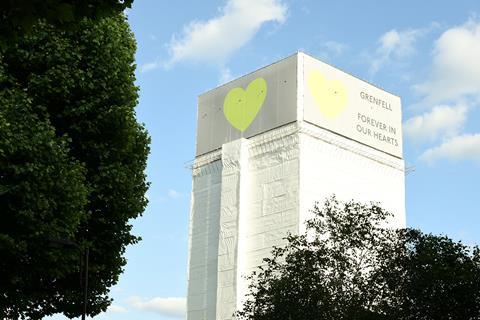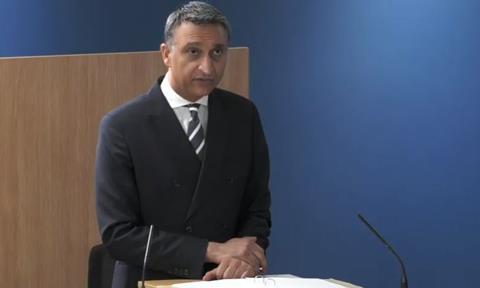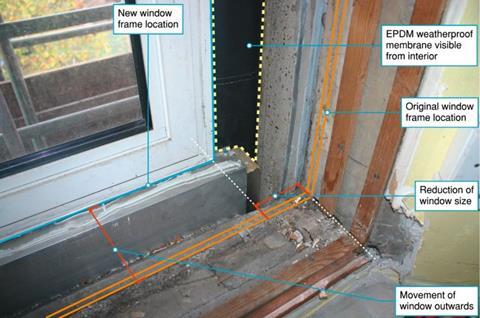Opening statement from original refurb architect also expresses ‘deep and profound sorrow’ over tragedy

The architect responsible for the original proposals to put cladding on Grenfell Tower has told the inquiry it believed the regulatory system for buildings had been unfit for purpose for many years before 2017’s tragedy.
In an opening statement to the second part of the Grenfell Inquiry, Studio E’s barrister said the practice had been “truly devastated” by the fire at the west London tower block, which claimed 72 lives, and that it thoroughly supported the aims of the wide-ranging investigation.
Prashant Popat said three current members of staff at the Southwark-based practice and one former colleague would give evidence to the inquiry’s second phase, and were keen to explore the firm’s role and whether doing anything differently could have resulted in a different outcome.
He said staff at Studio E felt a “deep and profound sorrow for the tragedy that befell the occupants of Grenfell Tower, all those involved in the rescue attempts following the fire, all their loved ones, and all others affected as circles of appalling consequences rippled outwards” from the events of 14 June 2017.
But the practice’s barrister suggested that failings with the regulatory system and an industry-wide lack of understanding of the suitability of aluminium composite material (ACM) cladding would be Studio E’s key contributions.
He also pointed to Ministry of Housing, Communities and Local Government figures indicating that some 436 other buildings had been fitted with unsafe cladding before the Grenfell Tower fire.

“Studio E does believe that the relevant regulator system was not fit for purpose and appears to have permitted the routine use of unsafe cladding materials on buildings for many years,” Popat said.
“Product manufacturers produced materials and testing data which had the effect of misleading designers to consider that their products were safe.
“At the time of the project, Studio E did not have any knowledge that the products used on the tower were unsafe and there was no information available to it – or, as it understands – to other architects and designers which would have reasonably alerted it to any lack of safety.
“Studio E does consider that it acted as would be expected of a reasonably competent architect in its position.”
The practice’s barrister said Studio E considered it had consulted widely with manufacturers and the project’s specialist consultants – including fire-safety specialists Exova and thermal performance adviser Max Fordham – as part of the design process.
“While various issues were raised which were then considered and resolved – such as cost, durability, method of installation, procurement factors and the like – none of these consultants or suppliers raised any concerns surrounding the brief to overclad the tower or the compliance of the cladding and its components with the building regulations,” Popat said.
“In fact, Studio E was directed to other high-rise residential buildings using similar materials to those under consideration for the tower.”

The barrister added that a fire strategy report from Exova on compliance with Part B4 of the Building Regulations had said the overcladding proposals would “have no adverse effect on the building in relation to external fire spread”.
Popat said Fordham had proposed the use of Celotex FR5000 for the rainscreen cladding insulation of the tower.
He added that Studio E also disputed elements of a yet-to-be-published 500-page report by inquiry expert architectural witness Paul Hyett, who is also a past president of the RIBA.
“Studio E’s preliminary analysis has identified numerous, what it regards as, technical or factual inaccuracies in key regards,” he said.
“Further, Studio E does disagree with many of the opinions expressed by Mr Hyett in that report.”
The first phase of the Grenfell Inquiry sought to establish the facts surrounding the outbreak of fire on July 14, 2017, and what happened during the hours that followed – including the rapidity with which fire spread and engulfed the 25-storey building.
>> Also read: Grenfell Inquiry: new details of tragic refurb emerge
>> Also read: Grenfell report backs ‘golden thread’ for high-rise buildings
The latest phase will look at decision-making up to that point and at the actions of key players, including Studio E which began working on the refurbishment of Grenfell Tower in 2012 after designing the neighbouring Kensington Aldridge Academy school.
Studio E’s role on the refurbishment changed when contractor Rydon was awarded a design-and-build contract for the project, a role that left it responsible for detailed design work.
However Studio E’s involvement with the project continued.
Panel member quits
Separately, inquiry panel member Benita Mehra resigned from her role as independent advisor to the inquiry panel over the weekend – barely a month after her appointment was announced.
The panel said prime minister Boris Johnson had accepted Mehra’s resignation following criticism that one of her previous roles had been supported by a donation from the Arconic Charitable Foundation. Arconic was the manufacturer of the ACM cladding used for the Grenfell refurbishment.
Mehra’s letter to Johnson said: “As you know, I had hoped to draw on my experience and knowledge of the construction industry, of community engagement and of governance within housing management to contribute to the vital work of the inquiry in discovering how and why the devastating fire at Grenfell Tower happened.
“However, it is apparent that my former role as president of the Women’s Engineering Society, which in 2017 accepted a charitable donation from the Arconic Charitable Foundation to support the mentoring of women engineers, has caused serious concern to a number of the bereaved, survivors and resident core participants.”
Mehra said that while she had not linked the donation – which was ring-fenced – to her Grenfell Inquiry role, it had been a “regrettable oversight” in hindsight.
















No comments yet